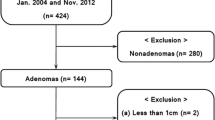Abstract
Purpose
To retrospectively compare computed tomography (CT) sensitivities of large (≥3 cm) adenoma and cortical carcinoma.
Methods
Between January 2004 and November 2012, 43 non-oncologic patients with 43 adrenal masses [31 large adenomas, and 12 carcinomas] underwent unenhanced CT, early contrast-enhanced CT, and delayed contrast-enhanced CT scans prior to adrenalectomy. Three types of region-of-interest (ROI) were used on early contrast-enhanced CT images:aROI (large ROI) covering more than half of a mass and two small ROIs fitted to the highest (high ROI) or lowest (low ROI) attenuation area. These ROIs were also placed in the same area on the other CT images. Adenoma was diagnosed if a mass measured ≤10 HU on unenhanced CT image, or if it had ≥60% absolute percentage washout (APW)or ≥40% relative percentage washout (RPW).Carcinoma was diagnosed if a mass had <60% APW and <40% RPW. CT sensitivities for large adenoma and carcinoma were compared.
Results
CT sensitivities for large adenoma vs. carcinoma were 64.5% (20/31) vs. 100% (12/12) using a large ROI, 100% (31/31) vs. 50.0% (6/12) using a high ROI, and 51.6% (16/31) vs. 100% (12/12) using a low ROIs, respectively.
Conclusions
CT sensitivities for large adenoma and cortical carcinoma are influenced by the size or location of an ROI.A large ROI helps to minimize loss of CT sensitivity for large adenoma and to detect carcinoma.





Similar content being viewed by others
References
Caoili EM, Korobkin M, Francis IR, Cohan RH, Dunnick NR (2000) Delayed enhanced CT of lipid-poor adrenal adenomas. AJR Am J Roentgenol 175:1411–1415
Caoili EM, Korobkin M, Francis IR, et al. (2002) Adrenal masses: characterization with combined unenhanced and delayed enhanced CT. Radiology 222:629–633
Korobkin M, Brodeur FJ, Francis IR, et al. (1998) CT time-attenuation washout curves of adrenal adenomas and nonadenomas. AJR Am J Roentgenol 170:747–752
Pena CS, Boland GW, Hahn PF, Lee MJ, Mueller PR (2000) Characterization of indeterminate (lipid-poor) adrenal masses: use of washout characteristics at contrast-enhanced CT. Radiology 217:798–802
Park BK, Kim CK, Kim B, Lee JH (2007) Comparison of delayed enhanced CT and chemical shift MR for evaluating hyperattenuating incidental adrenal masses. Radiology 243:760–765
Paulsen SD, Nghiem HV, Korobkin M, Caoili EM, Higgins EJ (2004) Changing role of imaging-guided percutaneous biopsy of adrenal masses: evaluation of 50 adrenal biopsies. AJR Am J Roentgenol 182:1033–1037
Szolar DH, Korobkin M, Reittner P, et al. (2005) Adrenocortical carcinomas and adrenal pheochromocytomas: mass and enhancement loss evaluation at delayed contrast-enhanced CT. Radiology 234:479–485
Park BK, Kim B, Ko K, Jeong SY, Kwon GY (2006) Adrenal masses falsely diagnosed as adenomas on unenhanced and delayed contrast-enhanced computed tomography: pathological correlation. Eur Radiol 16:642–647
Johnson PT, Horton KM, Fishman EK (2009) Adrenal mass imaging with multidetector CT: pathologic conditions, pearls, and pitfalls. Radiographics 29:1333–1351
Newhouse JH, Heffess CS, Wagner BJ, et al. (1999) Large degenerated adrenal adenomas: radiologic-pathologic correlation. Radiology 210:385–391
Aubert S, Wacrenier A, Leroy X, et al. (2002) Weiss system revisited: a clinicopathologic and immunohistochemical study of 49 adrenocortical tumors. Am J Surg Pathol 26:1612–1619
Lau SK, Weiss LM (2009) The Weiss system for evaluating adrenocortical neoplasms: 25 years later. Hum Pathol 40:757–768
NIH (2002) NIH state-of-the-science statement on management of the clinically inapparent adrenal mass (“incidentaloma”). NIH Consens State Sci Statements 19:1–25
Kapoor A, Morris T, Rebello R (2011) Guidelines for the management of the incidentally discovered adrenal mass. Can Urol Assoc J 5:241–247
Angeli A, Osella G, Ali A, Terzolo M (1997) Adrenal incidentaloma: an overview of clinical and epidemiological data from the National Italian Study Group. Horm Res 47:279–283
Terzolo M, Ali A, Osella G, Mazza E (1997) Prevalence of adrenal carcinoma among incidentally discovered adrenal masses. A retrospective study from 1989 to 1994. Gruppo Piemontese Incidentalomi Surrenalici. Arch Surg 132:914–919
Mantero F, Arnaldi G (2000) Management approaches to adrenal incidentalomas. A view from Ancona, Italy. Endocrinol Metab Clin North Am 29:107–125, ix
Mantero F, Terzolo M, Arnaldi G, et al. (2000) A survey on adrenal incidentaloma in Italy. Study Group on Adrenal Tumors of the Italian Society of Endocrinology. J Clin Endocrinol Metab 85:637–644
Ctvrtlik F, Herman M, Student V, Ticha V, Minarik J (2009) Differential diagnosis of incidentally detected adrenal masses revealed on routine abdominal CT. Eur J Radiol 69:243–252
Boland GW, Lee MJ, Gazelle GS, et al. (1998) Characterization of adrenal masses using unenhanced CT: an analysis of the CT literature. AJR Am J Roentgenol 171:201–204
Choi YA, Kim CK, Park BK, Kim B (2013) Evaluation of adrenal metastases from renal cell carcinoma and hepatocellular carcinoma: use of delayed contrast-enhanced CT. Radiology 266:514–520
Seo JM, Park BK, Park SY, Kim CK (2014) Characterization of lipid-poor adrenal adenoma: chemical shift MRI and washout CT. AJR Am J Roentgenol 202(5):1043–1050
Kumar R, Xiu Y, Yu JQ, et al. (2004) 18F-FDG PET in evaluation of adrenal lesions in patients with lung cancer. J Nucl Med 45:2058–2062
Boland GW, Blake MA, Holalkere NS, Hahn PF (2009) PET/CT for the characterization of adrenal masses in patients with cancer: qualitative versus quantitative accuracy in 150 consecutive patients. AJR Am J Roentgenol 192:956–962
Kim YK, Park BK, Kim CK, Park SY (2013) Adenoma characterization: adrenal protocol with dual-energy CT. Radiology 267:155–163
Korobkin M, Brodeur FJ, Francis IR, et al. (1996) Delayed enhanced CT for differentiation of benign from malignant adrenal masses. Radiology 200:737–742
Conflict of interest
None of authors have conflict or interest or financial support to disclose.
Author information
Authors and Affiliations
Corresponding author
Rights and permissions
About this article
Cite this article
Park, S.Y., Park, B.K., Park, J.J. et al. CT sensitivities for large (≥3 cm) adrenal adenoma and cortical carcinoma. Abdom Imaging 40, 310–317 (2015). https://doi.org/10.1007/s00261-014-0202-1
Published:
Issue Date:
DOI: https://doi.org/10.1007/s00261-014-0202-1




